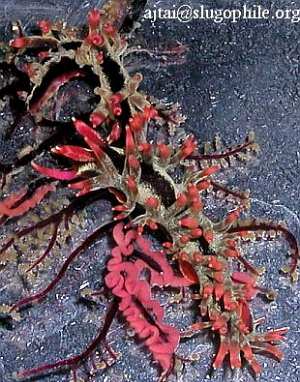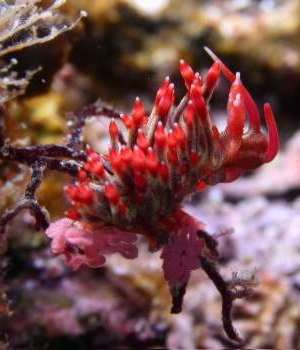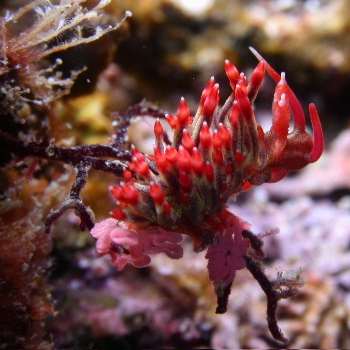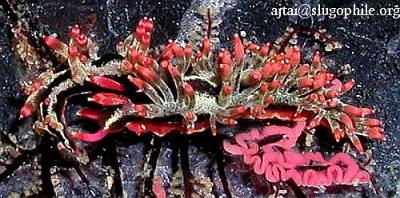

Hermosita hakunamatata
(Ortea, Caballer & Espinosa, 2003)
Order: NUDIBRANCHIA
Suborder: AEOLIDINA
Family: Glaucidae
DISTRIBUTION
It has a known distribution throughout the Mexican Pacific to Panama
PHOTO
Upper: Islas Murcielago, Costa Rica. 20ft. Photo: Peter Ajtai.. Lower: Isla Isabel, Nayarit, Mexico. Pacific Ocean. Depth: 32 feet. Length: 18 mm. 10 December 2003. Walls. Photo: Ali Hermosillo
Note added 8 February 2005: Previously known of the Forum as Flabellina sp. 3.
The animal is quite variable in colour. In dark specimens the body is black with opaque whitish bands down each side of the dorsum, consisting of opque whitish specks. The rhinophores and oral tentacles are translucent reddish pink, and the ceratal wall is covered in opaque whitish specks, except near the tip wher there is a band of reddish pink. The extreme tip of the cerata is white. In lighter coloured specimens, the black pigmentation is absent.
The pre cardiac and first two post cardiac groups of cerata on each side are arranged in single rowed arches, with up to 9 or 10 cerata in each arch. Behind that the cerata are arranged in sloping rows. The cerata have a distinct nipple-like tip, suggesting a cnidosac. The rhinophores bear numerous fine lamellae. The radular formula is 0.1.0 and the teeth, as illustrated in the original description, have a large pointed central cusp and approx 7 long pointed denticles on each side. It feeds on the hydroid Solanderia, and the dark colour form seems well camouflaged, the black central band on the dorsum, and whitish band on each side, matching the dark brown black trunk and whitish polyps of the Solanderia. It is reported to reach 18 mm in length. The egg ribbon is pinkish.
It was originally placed in the genus Phestilla [Family Tergipedidae], presumably on the shape of the radular teeth, but just from the information in the original description, this is most unlikely. For example, no tergipedid is known to have lamellate rhinophores, or cerata arranged in arches. One characteristic of the genus Phestilla is the replacement of the cnidosac with a swolen glandular tip to each ceras. From the photographs, this species almost certainly has cnidosacs. The long convoluted egg ribbon is also quite unlike that of any known species of Phestilla. While it is difficult to use the corallivorous feeding behaviour of all other species of Phestilla as a distinctive character, it should also be noted that this species is a hydroid feeder. See Alicia Hermisillo's message [#12811 ] in which she notes that 'its genus will be changed soon.... Sandra Millen and I have found the species to be a Hermosita rather than a Phestilla (no study of the reproductive system was done in the original description.'
-
Ortea, Jesus; Manuel Caballer and Jose Espinosa (2003) Nuevos Aeolidaceos (Mollusca:Gastropoda) de Costa Rica. Avicennia, 16: 129-142, figs. 1-4, 1 pl.
-
Hermosillo, Alicia (2004) Opisthobranch Mollusks of Parque Nacional de Coiba, Panamá. (Tropical Eastern Pacific). The Festivus, 36(9): 105-117.
Rudman, W.B., 2005 (February 9) Hermosita hakunamatata (Ortea, Caballer & Espinosa, 2003). [In] Sea Slug Forum. Australian Museum, Sydney. Available from http://www.seaslugforum.net/find/hermhaku
Related messages
Flabellina sp. 3 = Phestilla hakunamatata
February 11, 2005
From: Ali Hermosillo

.Dear Bill,
Congratulations on having the forum up again.
Updating Flabellina sp. 3, I have to tell you it has a name and its genus will be changed soon. This species has been named Phestilla hakunamatata Ortea, Caballer & Espinosa, 2003. Sandra Millen and I have found the species to be a Hermosita rather than a Phestilla (no study of the reproductive system was done in the original description).
It has a known distribution throughout the Mexican Pacific to Panama. The color of the species is quite variable, from the darker one seen in Peter´s picture to this more pink specimen. Feeds on the hydroid Solanderia sp.
Locality: Isla Isabel, Nayarit, Mexico. Pacific Ocean. Depth: 32 feet. Length: 18 mm. 10 December 2003. Walls. Photographer: Ali Hermosillo
-
Ortea, Jesus; Manuel Caballer and Jose Espinosa (2003) Nuevos Aeolidaceos (Mollusca:Gastropoda) de Costa Rica. Avicennia, 16: 129-142, figs. 1-4, 1 pl.
-
Hermosillo, Alicia (2004) Opisthobranch Mollusks of Parque Nacional de Coiba, Panamá. (Tropical Eastern Pacific). The Festivus, 36(9): 105-117.
Thanks!
Ali
gueri25@hotmail.com
Hermosillo, A., 2005 (Feb 11) Flabellina sp. 3 = Phestilla hakunamatata. [Message in] Sea Slug Forum. Australian Museum, Sydney. Available from http://www.seaslugforum.net/find/12811Dear Ali,
Thanks for this. I hadn't made the connection between this species and Peter Ajtai's Flabellina sp. 3 [message #6825]. As I have commented on the species' Fact Sheet, there is very little in its anatomy or biology to support its placement in the genus Phestilla.
Best wishes,
Bill Rudman
Flabellina from Costa Rica
May 8, 2002
From: Peter Ajtai


Note added 10 February 2005: This is now known on Forum as Hermosita hakunamatata.
Dear Bill,
I found these guys off the north western coast of Costa Rica, off a group of islands called the Islas Murcielago. There is a lot of upwelling in this area. I found the two nudibranchs at about 20ft at midday. I first saw the egg masses and only later noticed the nudibranchs themselves. Hopefully I'll have some underwater shots later, but I have to develop the film and scan it first. These photos are just with a digital camera.
What do you think these are? They have a small white papilla at the tip of each rhinophore. Protoaeolidiella atra look to be somewhat similar, but I don't think they are the same.
Thanks for your help, and I'll probably send some more photos of other branchs from the field trip...
PS: I am currently involved in helping out in the Guanacaste Nudibranch Project at the University of Costa Rica. I'm helping out with the webpage and with the diving for the project. Here is a page with some information about the project:
http://www.slugophile.org/page/project.html
Best wishes,
Peter Ajtai.
ajtai@slugophile.org
Ajtai, P., 2002 (May 8) Flabellina from Costa Rica. [Message in] Sea Slug Forum. Australian Museum, Sydney. Available from http://www.seaslugforum.net/find/6825Dear Peter,
Thanks for these interesting photos and any more will always be welcome. I don't rcognise this animal but someone with local knowledge may. It certainly has similarities to Protoaeolidiella but as your suggest it is most probably a species of Flabellina. Its colour pattern, with a black body and a broad whitish band down each side, is most unusual, and from your photos seems to be to camouflage it on the black-stalked hydroid on which you found it, much as Protoaeolidiella is so well camouflaged on its hyfroid Solanderia.
Best wishes,
Bill Rudman
